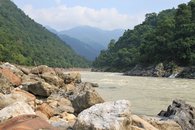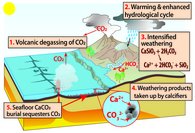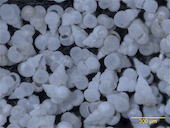OBJECT OF RESEARCH
On geological timescales, atmospheric CO2 levels – and with them the global climate – are regulated by a system of natural feedbacks. In our section, we study how these feedbacks operate, both today and in the geological past.Over the last few billion years, the Earth’s volcanoes and mid-ocean ridges have been steadily emitting CO2. Despite this, our planet has remained broadly habitable. The main reason for this is that CO2 is also continuously being drawn down from the atmosphere through chemical weathering reactions with the rocks at the Earth’s surface (see Figure 1). What’s more, if CO2 rises due to increasing volcanic injection, the climate warms, which speeds up the chemical weathering of rocks until the CO2 is drawn back down. This is called the ‘silicate weathering feedback’. Although this feedback is a powerful stabiliser on CO2 levels and climate, it can sometimes be temporarily overwhelmed by massive CO2 injection or perhaps weakened by a reduced availability of weatherable minerals. In both cases this leads to global warming events. Today’s global warming – caused by massive anthropogenic CO2 emissions – is almost unprecedented in its pace, rivalled only by the impact of a 20 km extra-terrestrial body at the end of the Cretaceous, 66 million years ago. To understand what this will mean for our planet in the future, it is essential that we understand how much the new CO2 in the atmosphere will warm our climate, and how critical compensating feedbacks will respond.
The release of CO2 into the atmosphere (1) warms the climate, and this warmer, wetter climate (2) accelerates the chemical weathering of silicate rocks on land; reactions that scavenge CO2 and convert it into dissolved bicarbonate ion, HCO3-. This dissolved carbon, along with cations (such as Ca2+) and silica, is then transported by rivers to the oceans (3), where calcifying marine organisms use it to produce CaCO3 (4). The eventual deposition of this CaCO3 on the seafloor retains carbon in the sediments (5), removing CO2 from the ocean-atmosphere system. This cools the climate, slows down weathering rates again and converges back to a stable atmospheric CO2 level.
OUR CONTRIBUTION TO RESEARCH
In our group, we approach these carbon cycle questions from multiple angles. On one hand, we characterise and explore the specific relevant (bio)geochemical processes that influence the CO2 cycling today, often down to the micron scale. At the same time, we learn from global events in geological history, using them as analogues or case studies on how changes in CO2 can affect the climate, biota and global carbon cycle.
To do this, we use state-of-the-art geochemical techniques made possible by the world class facilities in the HELGES Lab. These approaches include (to name a few):
- Measuring the boron isotope composition of foraminifera (see Figure 2) to reconstruct past atmospheric CO2 levels and carbon storage in the oceans.
The shells of these unicellular plankton, called foraminifera, record geochemical signatures of the waters they grew in within their calcium carbonate shells. At HELGES we use boron isotopes to estimate past ocean pH and CO2 levels. These individuals, of the species Heterohelix globulosa, were picked and isolated from sediments lain down just after the Cretaceous-Palaeogene boundary impact, 66 Million years ago.
- Using stable metal(loid) isotopes to track the chemical weathering processes that act to draw down CO2, both in the present day and in the geological past. This includes the use of Si isotopes and Li isotopes.
- Working out how much plants and other biota can influence the strength of the silicate weathering feedback, for example using Sr and Mg isotopes. Some of these investigations are carried out within the German-Chilean DFG Priority Programme ‘Earthshape’.
- Using cosmogenic Be isotopes to determine what controls the supply rate of fresh weatherable minerals by erosion, and how much absolute chemical weathering fluxes have (or have not) changed over geological time.
We complement these geochemical measurements with a range of Earth system models, from box models, to LOSCAR – a multi-box model with a representation of global ocean circulation, all the way to cGENIE, with basic atmospheric and ocean physics and dynamic biogeochemical and physical feedbacks.
PROJECTS
- coming soon!




